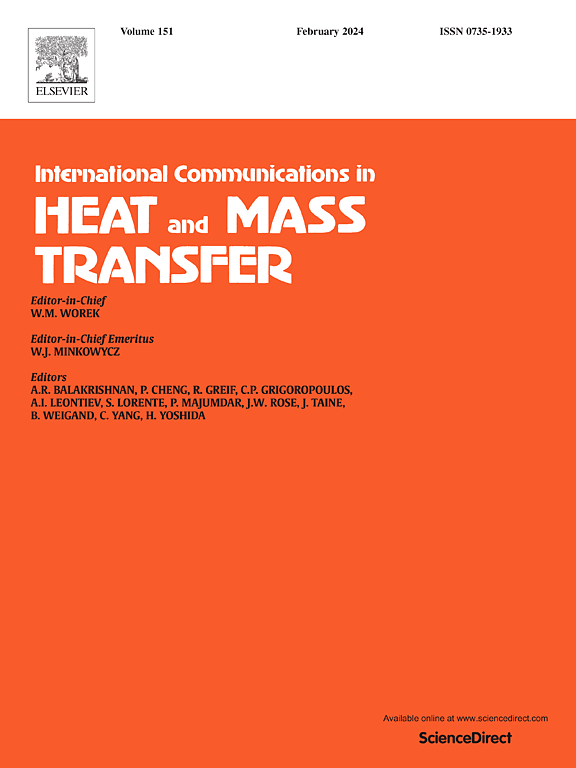Investigating heat generation and transfer in hygroscopic and exothermic textiles by 3D numerical model
IF 6.4
2区 工程技术
Q1 MECHANICS
International Communications in Heat and Mass Transfer
Pub Date : 2025-05-12
DOI:10.1016/j.icheatmasstransfer.2025.109053
引用次数: 0
Abstract
Due to the complex heat generation and transfer in the hygroscopic and exothermic textiles, the deep understanding of thermal regulating performance is still blur. In present manuscript, we developed a computational fluid dynamics (CFD) model based on weave structures in textile to investigate hygroscopic thermal generation and transfer phenomenon. The temperature changes were monitored when the textiles absorbed moisture from the surrounding atmosphere. We validated the proposed model by comparing the experimental and simulated data, with a strong correlation (above 0.938) and minimal discrepancies in temperature. Extensive parametric study was further conducted to clarify the hygroscopic heating performance and heat transfer characteristics. The simulation data revealed that higher areal density commonly resulted in greater moisture absorption and consequently increased heat generation. Moreover, enhanced thermal insulation can impede the heat transfer from the sample's interior to its surroundings, thereby facilitating hygroscopic heat accumulation and temperature increase in the sample. Additionally, the simulation under different ambient temperatures demonstrated that higher environmental temperatures led to more pronounced warming effects. Since the diminished temperature gradient could reduce heat dissipation through thermal radiation and convection between the sample and ambient environment.
利用三维数值模型研究吸湿和放热纺织品的热生成和传热
由于吸湿性和放热性纺织品中复杂的热生成和传递,对其热调节性能的深入认识仍然模糊不清。本文建立了基于织物组织结构的计算流体动力学(CFD)模型来研究织物的吸湿热生成和传递现象。当纺织品从周围大气中吸收水分时,对温度变化进行监测。通过对比实验数据和模拟数据,我们验证了所提出的模型,两者相关性强(大于0.938),且温度差异极小。进一步进行了广泛的参数研究,以阐明吸湿加热性能和传热特性。模拟数据显示,较高的面密度通常会导致更大的吸湿,从而增加热量的产生。此外,增强的绝热性可以阻止热量从样品内部传递到周围环境,从而促进样品的吸湿性热积累和温度升高。此外,不同环境温度下的模拟结果表明,环境温度越高,增温效应越明显。由于温度梯度的减小可以减少样品与周围环境之间通过热辐射和对流的散热。
本文章由计算机程序翻译,如有差异,请以英文原文为准。
求助全文
约1分钟内获得全文
求助全文
来源期刊
CiteScore
11.00
自引率
10.00%
发文量
648
审稿时长
32 days
期刊介绍:
International Communications in Heat and Mass Transfer serves as a world forum for the rapid dissemination of new ideas, new measurement techniques, preliminary findings of ongoing investigations, discussions, and criticisms in the field of heat and mass transfer. Two types of manuscript will be considered for publication: communications (short reports of new work or discussions of work which has already been published) and summaries (abstracts of reports, theses or manuscripts which are too long for publication in full). Together with its companion publication, International Journal of Heat and Mass Transfer, with which it shares the same Board of Editors, this journal is read by research workers and engineers throughout the world.

 求助内容:
求助内容: 应助结果提醒方式:
应助结果提醒方式:


